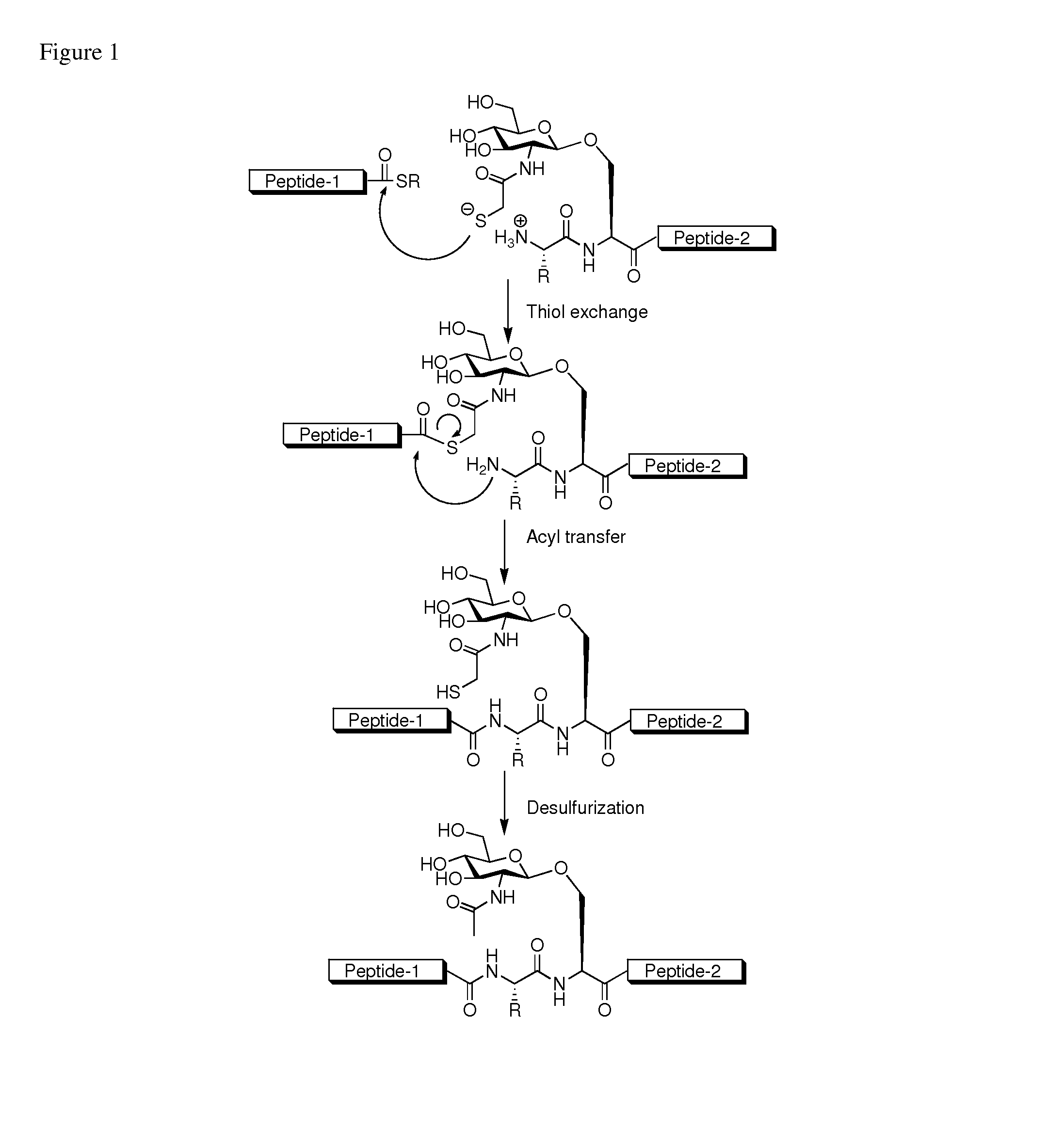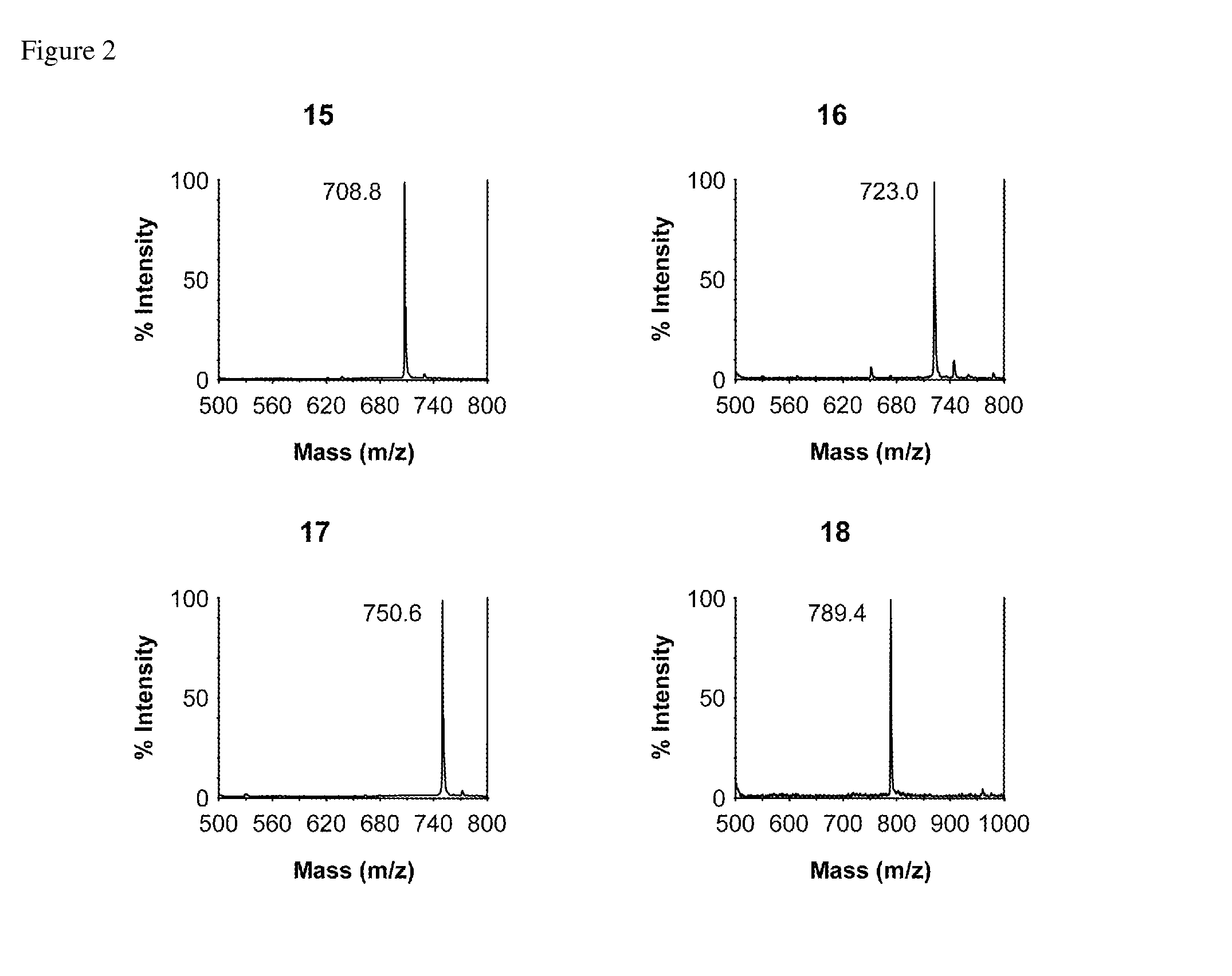Method of preparing glycopeptides
a glycopeptide and glycopeptide technology, applied in the field of glycopeptide preparation, can solve the problems that the sequence synthetic method is not well suited to the preparation of larger peptides and proteins, and achieve the effects of high yield, good purity and easy preparation
- Summary
- Abstract
- Description
- Claims
- Application Information
AI Technical Summary
Benefits of technology
Problems solved by technology
Method used
Image
Examples
example 1
[0141]
(a) FmocSer-OAllyl, TMSOTf, CH2Cl2, Molecular Sieves, −78° C.; (b) Zn, AcOH; (c) TrtS-CH2—COOH, HBTU, DIEA, DMF; (d) 20% piperidine in DMF; (e) Boc-Gly-OH, HBTU, HOBt, DIEA, DMF; (f) Pd(PPh3)4, NMA, THF, (g) H-Phe-NH2, HBTU, HOBt, DIEA, DMF; (h) 0.05N NaOH, MeOH, pH˜10; (i) TFA / Et3SiH / H2O (9 / 0.5 / 0.5).
example 2
[0142]Compound 5: Compound 4 (5.54 g, 8.92 mmol) was added to Fmoc-Ser-OAllyl (3.92 g, 10.70 mmol) and MS (AW-300, 5 g) in dry CH2Cl2 (30 mL). The reaction was kept under argon at room temperature for 1 h. The reaction mixture was then brought to −78° C. and TMSOTf (174 μL, 0.89 mmol) was added slowly. The reaction mixture was stirred at −78° C. for 1.5 h and quenched with addition of DIEA (155.3 μL, 0.89 mmol). The reaction mixture was filtered and filtrate was diluted with 20 mL of CH2Cl2 and washed with water. The organic layer was dried over MgSO4 and concentrated for flash column chromatography (EA / Hex, 1:2). The purified product (6.28 g, 85%) was then suspended in 20 mL of AcOH, and then Zn dust was added. The reaction mixture was stirred at rt for 8 h. After filtration the solvent was removed under vacuum, the residue was applied on flash column chromatography (EA / Hex, 3:1) to give compound 5 (4.36 g, 88%).
example 3
[0143]Compound 6: Compound 5 (1.0 g, 1.4 mmol) was added to preactivated S-trityl-2-mercaptoactic acid (932.4 mg, 2.8 mmol) with HBTU (1.06 g, 2.8 mmoL) and DIEA (1 mL, 5.6 mmoL) in dry DMF (10 mL). The reaction mixture was stirred under argon at rt for 2 h. The reaction solution was diluted with 80 mL of ethylacetate and washed with water, then brine. The organic layer was dried over MgSO4 and concentrated for flash column chromatography (EA / Hex 1:2). Compound 6 (1.0 g, 90%) was obtained as a white solid. 1H-NMR (CDCl3, 500 MHz): δ 7.76 (d, 2H, J=7.7 Hz), 7.60 (t, 2H, J=7.3 Hz), 7.13-7.42 (m, 20H), 5.87 (d, 1H, J=7.7 Hz), 5.67 (d, 1H, J=8.0 Hz), 5.31 (d, 1H, J=16.9 Hz), 5.21 (d, 1H, J=10.2 Hz), 5.16 (t, 1H, J=9.5 Hz), 4.96 (t, 1H, J=9.5 Hz), 4.64 (d, 1H, J=5.1 Hz), 4.56 (d, 1H, J=7.7 Hz), 4.50 (m, 1H), 4.36 (dd, 1H, J=9.2, 6.2 Hz), 4.20-4.25 (m, 2H), 4.06-4.12 (m, 3H), 3.80 (dd, 1H, J=10.6, 3.3 Hz), 3.60-3.66 (m, 2H), 3.01 (d, 1H, J=15.1 Hz), 3.07 (d, 1H, J=15.1 Hz), 2.05 (s, 1H), ...
PUM
| Property | Measurement | Unit |
|---|---|---|
| molar ratio | aaaaa | aaaaa |
| time period | aaaaa | aaaaa |
| time period | aaaaa | aaaaa |
Abstract
Description
Claims
Application Information
 Login to View More
Login to View More - R&D
- Intellectual Property
- Life Sciences
- Materials
- Tech Scout
- Unparalleled Data Quality
- Higher Quality Content
- 60% Fewer Hallucinations
Browse by: Latest US Patents, China's latest patents, Technical Efficacy Thesaurus, Application Domain, Technology Topic, Popular Technical Reports.
© 2025 PatSnap. All rights reserved.Legal|Privacy policy|Modern Slavery Act Transparency Statement|Sitemap|About US| Contact US: help@patsnap.com



